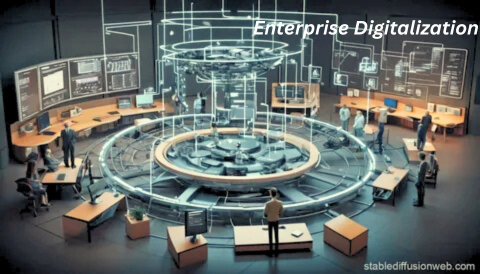Introduction
In the fast-paced world of technology and innovation, businesses are facing constant pressure to evolve. Traditional processes and outdated systems can no longer keep up with the demands of the modern marketplace. This is where enterprise digitalization becomes essential. It represents not just the adoption of digital tools but the transformation of an organization’s entire business model, culture, and operations through technology.
Today, enterprise digitalization is not merely a choice; it’s a necessity for survival and growth. Companies embracing it are gaining competitive advantages by improving efficiency, enhancing customer experiences, and driving innovation. From automation to AI-driven decision-making, the digital era is reshaping how enterprises function at every level.
Understanding Enterprise Digitalization
At its core, enterprise digitalization is the strategic integration of digital technologies into all areas of a business. It involves rethinking how organizations operate, communicate, and deliver value to their customers. Unlike simple digitization (which focuses on converting analog data to digital formats), enterprise digitalization is about transforming business processes to become more agile, data-driven, and customer-focused.
The goal of enterprise digitalization is to create a connected ecosystem where people, systems, and data work seamlessly together. This shift enhances productivity, optimizes resource use, and enables faster decision-making across departments.
Key Components of Enterprise Digitalization
Implementing enterprise digitalization requires a holistic approach. Some of the most critical components include:
- Cloud Computing
Cloud technology serves as the backbone of enterprise digitalization. It provides scalability, flexibility, and cost efficiency, allowing organizations to store, manage, and access data from anywhere. - Data Analytics and Artificial Intelligence (AI)
Enterprise digitalization heavily relies on data-driven insights. AI and analytics help companies make smarter decisions, predict market trends, and personalize customer interactions. - Automation and Robotics
Process automation is one of the most visible results of enterprise digitalization. By automating repetitive tasks, businesses can reduce human error and focus on strategic innovation. - Cybersecurity
As organizations become more connected, protecting digital assets becomes crucial. Enterprise digitalization includes advanced cybersecurity measures to safeguard data and systems from evolving threats. - Internet of Things (IoT)
IoT enhances enterprise digitalization by connecting physical devices with digital systems, enabling real-time monitoring and intelligent operations across industries like manufacturing, logistics, and healthcare.
Benefits of Enterprise Digitalization
The advantages of enterprise digitalization are both immediate and long-term. Here are some of the most impactful benefits:
- Enhanced Efficiency: Automated workflows and AI-driven insights streamline operations and reduce time wastage.
- Improved Customer Experience: Enterprise digitalization helps businesses understand customer needs better, offering personalized products and services.
- Cost Reduction: With digital tools and cloud solutions, companies can cut down operational expenses significantly.
- Faster Decision-Making: Data-driven insights empower leaders to make quick and accurate business decisions.
- Innovation and Agility: Through enterprise digitalization, companies can quickly adapt to market shifts and technological changes.
Challenges in Enterprise Digitalization
While the benefits are immense, enterprise digitalization also brings certain challenges that organizations must navigate carefully:
- Cultural Resistance: Employees often resist digital change due to fear of the unknown or job displacement.
- Integration Complexity: Legacy systems can make it difficult to fully integrate new digital solutions.
- Cybersecurity Risks: Increased connectivity means more exposure to cyber threats.
- Cost of Implementation: Though digitalization offers long-term savings, the initial investment can be high.
To overcome these challenges, enterprises must focus on change management, continuous training, and strategic leadership.
Strategies for Successful Enterprise Digitalization
Success in enterprise digitalization depends on how effectively an organization plans and executes its digital journey. Here are some key strategies:
- Develop a Clear Vision: Establish a well-defined roadmap aligned with business goals.
- Invest in the Right Technology: Choose scalable and secure digital solutions that fit the company’s size and industry.
- Empower Employees: Encourage a culture of innovation by reskilling employees and involving them in the digital transformation process.
- Adopt Data-Driven Decision Making: Make analytics central to every business operation to achieve better outcomes.
- Focus on Customer Experience: Ensure digitalization improves how customers interact with the brand.
With these strategies, enterprise digitalization becomes not just a technical upgrade but a complete business evolution.
The Role of Leadership in Enterprise Digitalization
Leadership plays a vital role in driving enterprise digitalization. Executives must lead by example, embrace digital thinking, and foster a culture of continuous innovation. A digitally mature leadership ensures collaboration between IT and business units, creating a unified approach toward transformation.
Visionary leaders also recognize that enterprise digitalization is not a one-time project; it’s an ongoing journey. The ability to adapt, experiment, and evolve continuously is what separates successful enterprises from stagnant ones.
The Future of Enterprise Digitalization
Looking ahead, enterprise digitalization will continue to shape industries in unprecedented ways. Emerging technologies like AI, blockchain, and quantum computing will further revolutionize how businesses operate. The integration of these tools will make enterprises more intelligent, automated, and customer-centric.
Moreover, sustainability will become a key part of enterprise digitalization, as companies use technology to reduce waste, optimize resources, and achieve environmental goals. The future belongs to organizations that can harness digital power to create long-term value for both their business and society.
Conclusion
Enterprise digitalization is redefining the rules of business. It’s not just about adopting technology it’s about transforming mindsets, processes, and goals. In today’s dynamic landscape, businesses that fail to embrace enterprise digitalization risk falling behind their competitors. But those that do it right can achieve exponential growth, innovation, and resilience.
Ultimately, enterprise digitalization is the bridge between today’s challenges and tomorrow’s opportunities. By leveraging digital tools strategically, enterprises can unlock new possibilities and ensure their place in the future of business.
